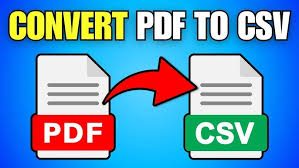Blog Post: PDF to CSV—Easily Convert PDF Tables to CSV Format

In an age where data reigns supreme, PDFs remain one of the most commonly exchanged formats—secure and universal, yes, but also notoriously difficult to extract information from. That’s why PDF to CSV conversion is often front and center for professionals looking to unlock data trapped inside invoices, reports, surveys, and more.
Understanding PDF to CSV
PDF (Portable Document Format) is designed for presentation, not data extraction. While it preserves layout and readability, PDFs obscure the underlying structure, making it tricky to copy tables or text cleanly. Enter CSV (Comma-Separated Values): a lightweight, plain-text format built for representing tabular data. It’s simple, interoperable, and works with spreadsheets, databases, and analytics tools. Converting PDF to CSV gives you the flexibility to manipulate, analyze, and integrate that data effectively.
Why You Should Convert PDF to CSV
- Data Analysis: Whether it’s Excel, Google Sheets, or advanced analytics tools, CSV files are much easier to import and analyze than static PDFs.
- Efficiency and Accuracy: Manual data entry is slow and prone to human error. Reliable PDF to CSV converters speed up work and reduce mistakes.
- Automation Ready: Many APIs and desktop tools support batch or programmatic conversion—ideal for recurring workflows.
- Cross-Platform Compatibility: CSV is virtually universal across platforms and applications, unlike some proprietary formats.
How to Convert PDF to CSV
There are multiple pathways depending on your use case:
- Online Converters: Fast and accessible. Upload your PDF, choose CSV, and download the output. Great for quick one-off tasks.
- Desktop Software: Tools like Adobe Acrobat Pro enable export to Excel, which you can then save as CSV—ideal for more control over formatting.
- Scripts & Libraries: Developers can leverage Python libraries such as Tabula, Camelot, or pdfplumber to automate conversions, especially useful for large batches or custom parsing logic.
- Advanced Parsing Services: Platforms like Mailparser or Docparser offer rule-based extraction (and OCR when needed), perfect for high-volume, structured conversions with accuracy control.
Best Practices for Clean Conversion
- High-Quality Source PDF: Clear scans or native text PDFs produce the best results.
- Inspect Tables: Ensure that the data in the PDF is formatted in recognizable rows and columns.
- Preview and Clean Output: Even automated tools may misplace headers or merge cells—always review the CSV for consistency.
- Use OCR Wisely: If PDFs are scanned images, choose tools with OCR capabilities. Just be aware that OCR introduces its own potential for misreads.
Applications That Benefit Most
- Finance Teams: Extract data from bank statements, invoices, or billing records.
- Researchers & Academics: Pull tabular data from reports or journals for statistical analysis.
- Logistics & Inventory: Convert shipping manifests or inventory lists into manageable databases.
- Small Businesses: Automate data entry from vendor forms or order sheets to sync with their CRM or spreadsheets.
Wrapping Up
Converting PDF to CSV isn’t just a format shift—it’s a transformation that turns static content into actionable data. Whether you’re doing a one-time conversion or setting up an automated workflow, choosing the right method—online tools, desktop software, scripting, or parsing platforms—can unlock efficiency and accuracy for your business or project.
FAQ
- What’s the difference between PDF, Excel, and CSV?
- PDF is not designed for data extraction and focuses on preserving formatting.
- Excel (.xlsx) supports formulas, formatting, and styling.
- CSV is plain text with values separated by commas—lightweight and highly compatible.
2. Are there free tools to convert PDF to CSV?
- Yes—many online converters, open-source Python libraries, and even built-in tools like macOS Preview (with manual steps) allow basic conversion at no cost.
3. Can I convert scanned PDFs to CSV?
- Yes—but you’ll need OCR (Optical Character Recognition) functionality, which services like Docparser or advanced tools support.
4. Is there a limit to file size or batch processing with online converters?
- Terms vary by tool. Free online services may limit file size or number of pages, so check their guidelines or opt for desktop tools or APIs for high-volume use.
5. How accurate is Python-based conversion?
- Libraries like Tabula or Camelot do a solid job with structured PDFs. The accuracy depends on the layout complexity and PDF quality—manual review is still recommended.